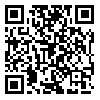Volume 18, Issue 2 (2-2019)
ijdld 2019, 18(2): 64-70 |
Back to browse issues page
Download citation:
BibTeX | RIS | EndNote | Medlars | ProCite | Reference Manager | RefWorks
Send citation to:



BibTeX | RIS | EndNote | Medlars | ProCite | Reference Manager | RefWorks
Send citation to:
Aligholipour M, Feizollahzadeh H, Ghaffari M, Jabbarzadeh F. THE EFFECT OF IN-PERSON AND MULTIMEDIA SHORT MESSAGE BASED EDUCATION IN TELEGRAM ON FASTING BLOOD GLUCOSE AND GLYCOSYLATED HEMOGLOBIN IN PATIENTS WITH INSULIN-DEPENDENT DIABETES. ijdld 2019; 18 (2) :64-70
URL: http://ijdld.tums.ac.ir/article-1-5731-en.html
URL: http://ijdld.tums.ac.ir/article-1-5731-en.html
1- Department of Medical-Surgical Nursing, Nursing and Midwifery Faculty, Tabriz University of Medical Sciences, Tabriz, Iran
2- Department of Medical-Surgical Nursing, Nursing and Midwifery Faculty, Tabriz University of Medical Sciences, Tabriz, Iran ,hosseinfeizalahzadeh@gmail.com
3- Department of Psychology, Payame Noor University (PNU), Malekan, Iran
2- Department of Medical-Surgical Nursing, Nursing and Midwifery Faculty, Tabriz University of Medical Sciences, Tabriz, Iran ,
3- Department of Psychology, Payame Noor University (PNU), Malekan, Iran
Abstract: (3599 Views)
Background: Patients with diabetes need to be educated efficiently and effectively in order to increase their quality of life. According to modern technological developments, multimedia message-based education is considered as one of the effective educational strategies. The purpose of this study was to investigate the effect of multimedia-based education in the Telegram application and in-person method on fasting blood glucose and glycosylated hemoglobin levels in patients with insulin-dependent diabetes.
Methods: In this clinical trial study, a sample of 66 patients with insulin-dependent diabetes who referred to the emergency department and the clinic of Sina hospital in Tabriz, were randomly assigned in double blocks into two groups: in-person education and multimedia-based education. Data gathering tools included a demographic form, glycosylated hemoglobin and fasting blood glucose were measured before and three months after the educational intervention. Data were analyzed with independent and paired samples t-tests.
Results: The results indicated that there were no significant differences in the mean values of glycosylated hemoglobin and fasting blood glucose between two groups before and after education(P >0.05). In within-group comparison, there was a statistically significant difference in the multimedia message group on the reduction of mean values of glycosylated hemoglobin (p= 0.02) but these values differences were not significant in in-person group (p= 0.33).
Conclusion: Multimedia-based education in the Telegram application compared to in-person education improves self-care and reduces the mean values of glycosylated hemoglobin in diabetic patients. This educational context can be used to facilitate the self-care education process to patients.
Methods: In this clinical trial study, a sample of 66 patients with insulin-dependent diabetes who referred to the emergency department and the clinic of Sina hospital in Tabriz, were randomly assigned in double blocks into two groups: in-person education and multimedia-based education. Data gathering tools included a demographic form, glycosylated hemoglobin and fasting blood glucose were measured before and three months after the educational intervention. Data were analyzed with independent and paired samples t-tests.
Results: The results indicated that there were no significant differences in the mean values of glycosylated hemoglobin and fasting blood glucose between two groups before and after education(P >0.05). In within-group comparison, there was a statistically significant difference in the multimedia message group on the reduction of mean values of glycosylated hemoglobin (p= 0.02) but these values differences were not significant in in-person group (p= 0.33).
Conclusion: Multimedia-based education in the Telegram application compared to in-person education improves self-care and reduces the mean values of glycosylated hemoglobin in diabetic patients. This educational context can be used to facilitate the self-care education process to patients.
Type of Study: Research |
Subject:
Special
Received: 2018/07/5 | Accepted: 2019/01/12 | Published: 2019/02/15
Received: 2018/07/5 | Accepted: 2019/01/12 | Published: 2019/02/15
Send email to the article author
| Rights and permissions | |
 |
This work is licensed under a Creative Commons Attribution-NonCommercial 4.0 International License. |





